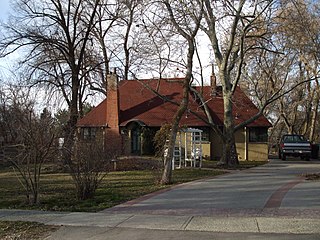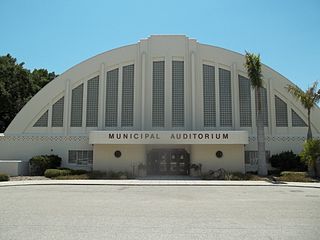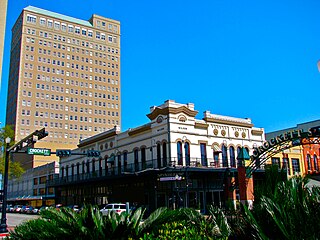
The Civil Works Administration (CWA) was a short-lived job creation program established by the New Deal during the Great Depression in the United States to rapidly create mostly manual-labor jobs for millions of unemployed workers. The jobs were merely temporary, for the duration of the hard winter of 1933–34. President Franklin D. Roosevelt unveiled the CWA on November 8, 1933, and put Harry L. Hopkins in charge of the short-term agency.

The Works Progress Administration was an American New Deal agency, employing millions of job-seekers to carry out public works projects, including the construction of public buildings and roads. It was established on May 6, 1935, by presidential order, as a key part of the Second New Deal.

Davis County is a county in northern Utah, United States. As of the 2010 United States Census, the population was 306,479, making it Utah's third-most populous county. Its county seat is Farmington, and its largest city is Layton.

Farmington is a city in Davis County, Utah, United States. It is part of the Ogden–Clearfield, Utah Metropolitan Statistical Area. The population was 18,275 at the 2010 census and was estimated at 25,339 in 2019. An amusement park, called Lagoon Amusement Park, is located in Farmington.

Fruit Heights is a city in eastern Davis County, Utah, United States. It is part of the Ogden–Clearfield, Utah Metropolitan Statistical Area. It lies along the Wasatch Front adjacent to the larger cities of Farmington and Kaysville. Its population was 4,987 at the 2010 census, with an estimated population of 6,234 in 2018.

Kaysville is a city in Davis County, Utah. It is part of the Ogden–Clearfield metropolitan area. The population was 27,300 at the time of the 2010 census, with an estimated population of 32,390 in 2019.

The Civic Center in San Francisco, California, is an area located a few blocks north of the intersection of Market Street and Van Ness Avenue that contains many of the city's largest government and cultural institutions. It has two large plazas and a number of buildings in classical architectural style. The Bill Graham Civic Auditorium, the United Nations Charter was signed in the Veterans Building's Herbst Theatre in 1945, leading to the creation of the United Nations. It is also where the 1951 Treaty of San Francisco was signed. The San Francisco Civic Center was designated a National Historic Landmark in 1987 and listed in the National Register of Historic Places on October 10, 1978.

Salt Lake City, Utah has many historic and notable sites within its immediate borders. Although the entire Salt Lake City metropolitan area is often referred to as "Salt Lake City", this article is concerned only with the buildings and sites within the official city limits of Salt Lake City.

Davis School District is a school district serving Davis County, Utah, United States. Headquartered in the county seat of Farmington, it is the 61st largest school district in the United States and the 2nd largest school district in Utah with 72,987students attending Davis schools as of 2019. It is located almost entirely within Davis County. Students attend elementary school from kindergarten to 6th grade, junior high from 7th grade-9th grade, and high school from 10th grade-12th grade.

LeConte Stewart was a Latter-day Saint artist primarily known for his landscapes of rural Utah. His media included oils, watercolors, pastel and charcoal, as well as etchings, linocuts, and lithographs. His home/studio in Kaysville, Utah is on the National Register of Historic Places.

The Sarasota Municipal Auditorium, listed in the National Register as Municipal Auditorium-Recreation Club, is a historic multi-purpose facility built in 1938. It is located at 801 Tamiami Trail North and owned/operated by the municipal government of Sarasota, Florida. The auditorium has 10,000 square feet (930 m2) of exhibit space on its main floor and also contains an Art Deco style stage measuring 1,500 square feet (140 m2).

Literary Hall is a mid-19th-century brick library, building and museum located in Romney, a city in the U.S. state of West Virginia. It is located at the intersection of North High Street and West Main Street. Literary Hall was constructed between 1869 and 1870 by the Romney Literary Society.

The Civic Center Music Hall is a performing arts center located in Oklahoma City, Oklahoma. It was constructed in 1937 as Municipal Auditorium and renamed in 1966. The facility includes the Thelma Gaylord Performing Arts Theatre, the Freede Little Theatre, CitySpace, the Meinders Hall of Mirrors and the Joel Levine Rehearsal Hall.

East Layton is a former city in Davis County, Utah, United States. Adjacent to Layton, it was incorporated in 1936 in order to secure funding for a community water system. East Layton remained a small, steadily growing residential town for decades, becoming a city in 1972. Rapid expansion during the 1970s led to a merger in 1981 with Layton, now Davis County's most populous city and one of the largest in Utah.

The Delaware Historical Society began in 1864 as an effort to preserve documents from the Civil War. Since then, it has expanded into a statewide historical institution with several buildings, including Old Town Hall and the Delaware History Museum, in Wilmington and the historic Read House & Gardens in New Castle.

The Beaumont Commercial District is located in Downtown Beaumont, Texas. The district consists of various styles of buildings, including 6 highrises built before 1932. The district is registered on the National Register of Historic Places as a U.S. Historic District. The historic district is roughly bounded by Willow, Neches, Gilbert and Main Streets. The Old Spanish Trail travels through Downtown on Willow, Park, Pearl and College Streets.

The Superintendent's Residence at the Utah State Hospital is a historic house located at the Utah State Hospital in east Provo, Utah, United States. It was listed on the National Register of Historic Places in 1986.
William Robert Allen was an early 20th-century architect in Utah. His most important work, the Davis County Courthouse, is no longer extant, yet a number of his works are listed on the U.S. National Register of Historic Places. Allen received training through the International Correspondence Schools which was based in Scranton, Pennsylvania, but allowed him to receive training and continue work in Utah.

The Carson City Civic Auditorium, at 813 N. Carson St. in Carson City, Nevada, was designed by architect Lehman A. Ferris and was built during 1938–39. It was funded by a municipal bond and by the Public Works Administration. Also known simply as Municipal Auditorium, it was listed on the National Register of Historic Places in 1990. Since 1994, the building has served as the location for the Children’s Museum of Northern Nevada.

PWA Moderne is an architectural style of many buildings in the United States completed between 1933 and 1944, during and shortly after the Great Depression as part of relief projects sponsored by the Public Works Administration (PWA) and the Works Progress Administration (WPA).




















